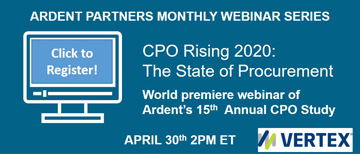With the World Premiere Webinar of my 15th annual CPO Rising / State of Procurement research just a few hours away (it’s not too late to register), I’ve decided that over the next few weeks, we’re going to revisit each of the earlier editions of this research effort.
Today, I’m going to give you the “throwback of all throwbacks” and dig deep into the archives to share a few excerpts from my first annual CPO report. Contact us here and I’ll have my team send you a copy of that first CPO report.
Procurement has the dubious distinction of being at the center of all enterprise activity at the same time it is on the fringes. Unless you are a procurement outsourcing service provider, there are very few exceptions where procurement is considered the single most important core competence of an organization. And yet the very essence of any enterprise is buying and selling goods or services. Sales is obviously considered to be a top function in most organizations. Why wouldn’t the corresponding procurement function be regarded similarly? Fortunately, 89% of our respondents indicated that the procurement function has grown more strategic over the last three years. Yet procurement is still emerging as a respected discipline…. If procurement is more than administrative overhead and can actually add value, then the top ten goal to get more spend under management makes a lot of sense, and the goal to invest in the people behind that makes even more sense…
Accurate spend data is perhaps the most powerful tool for CPOs as they work to gain executive support and end user compliance. But the data alone is not enough. It must be meticulously analyzed and carefully presented in a unique way for each of the various constituencies previously identified: executives, end users, procurement team members and suppliers…
Executive management wants to see spend data presented in the same terms that enterprise financial performance is measured. For public companies this often equates to EPS (earnings per share). However, the positive impact of cost cutting on net income is valid for enterprises of any shape or size. For publicly traded companies an increase in net income leads to greater EPS and ultimately a higher market value. For other enterprises the increase in net income simply means more profit and/or the ability to provide more products or services to external customers. Other financial metrics to be considered include ROIC (return on invested capital), WACC (weighted average cost of capital), and EVA (economic value add). If ROIC is greater than WACC then EVA is positive and you are adding value to the organization. This data is best presented in a simple dashboard that is easily accessible and provides ample drill-down capabilities for additional details by time, product or service line, sub-organization, geography, commodity and supplier. Presenting data to procurement team members should largely follow the same rules as for executive management. However, end users need the data presented in an equally simple view, but not usually with the same backing details or even financially-focused terminology. The presentation should take on more of a sales and marketing twist such that they are enticed to work with procurement as much as they are compelled…
Best-in-Class CPOs clearly understand the importance of their employees, internal customers, executive sponsors and suppliers. Getting more spend under management involves all of these groups. End users who are aware of the benefits, have a relationship with procurement and self-service tools at their fingertips are more likely get procurement involved early in the process. After all, “spend under management” should be much more than just a single touch at the time a PO is issued. The earlier procurement gets involved the better the chances are for savings. Executives who support procurement, including CPOs themselves, understand the value of well-defined policies and procedures along with the procurement staff members and systems that support them. 51% of Best in Class enterprises plan to invest in skills development for their staff. Nearly 69% plan to hire more strategic sourcing, category management and supplier relationship specialists…
The Chief Procurement Officer of a large European financial services organization cited the fact that his procurement organization was highlighted in the company’s annual report. Furthermore, on multiple company earnings calls the CEO has mentioned the positive financial contribution of procurement. This is viewed both internally and externally as a significant indicator of success that can help drive additional support and improvements for procurement…
After re-reading the entire report this week, one thing is certain – we have come a long way (baby!).
RELATED CPO RESEARCH
APRIL 30 @ 2:00 PM – 3:00 PM – CPO Rising 2020 Study: Continuity, Resilience, Recovery
ON-DEMAND – CPO Strategies: Paving the Road to Recovery
ON-DEMAND – CPO Playbook: Leveraging Your Network To Ensure Supply in the Age of Corona
Tagged in: Ardent Partners Research, Chief Procurement Officer, CPO, CPO Shop Talk, People, Throwback Thursday










